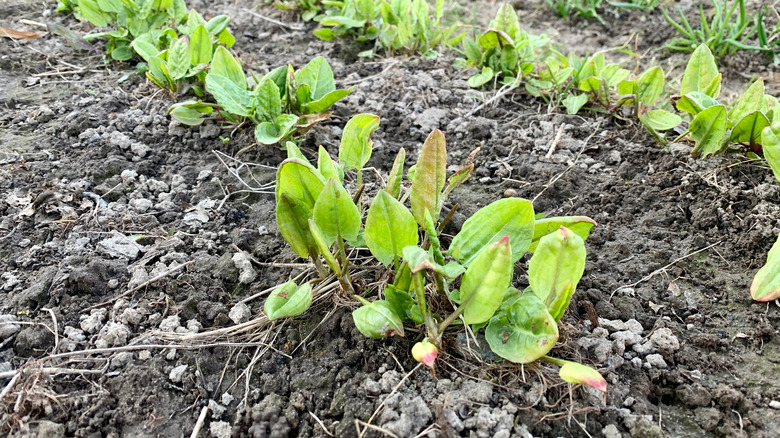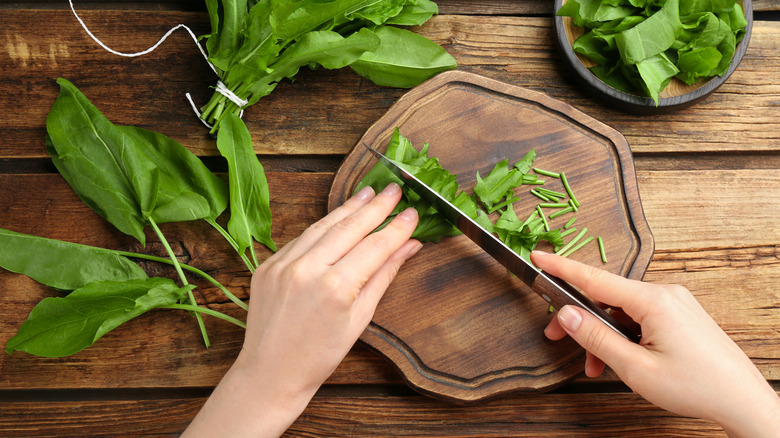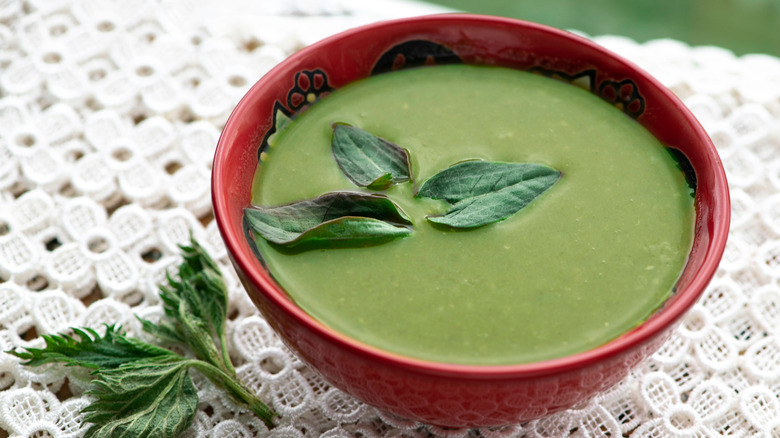What Is Sorrel And What Is It Used For?
Even if greens aren't your favorite food group, eating enough of them is easy when you know some simple salads and delicious vegetable recipes. But even with a variety of recipes, eating the same types of veggies over and over can get a little bit tiring. If you're eating the same leafy greens in your salad again and again, it might be time to try sorrel. It's a wonderful addition to meals that need a little bit of brightness or a lemony flavor. Though sorrel may not be common in some of the United States' favorite foods, you can find the ingredient in Nigerian, Vietnamese, Hungarian, Romanian, Russian, and Indian cuisine (per the Food Republic)
This guide breaks down what types of sorrel there are, what this leafy green tastes like, and provides some suggestions on how to cook with this ingredient. For anyone looking to try sorrel for the first time, here's what you need to know.
What is sorrel?
There are a few different types of sorrel (sometimes this plant is also called dock), which The Spruce Eats breaks down for us. The outlet says that common and French sorrel are cultivated, while Sheep's sorrel gets foraged. You're most likely to find common sorrel in grocery stores or farmers' markets. This particular variety has a stronger and sharper flavor than milder types like French or red-veined sorrel, but any of them can be used in cooking. There's also an ingredient called Jamaican sorrel, but don't get this mixed up with the leafy green kind! (The Kitchn says that Jamaican sorrel is actually another name for hibiscus blossoms.)
Epicurious explains that sorrel season starts during the spring, and the plant can be harvested all the way through fall, though the leaves become more bitter over time. The outlet also mentions that sorrel is an easy plant to take care of and grows quickly, making it a great crop to add to backyard or kitchen gardens.
What does sorrel taste like?
Sorrel has a distinct taste, especially for a leafy green (although greens like arugula also have a sharp flavor). Generally, sorrel has a sour flavor that many people compare to lemons. According to The Kitchn, "The closest taste to mature sorrel leaves is one that you wouldn't expect: A tart, sour green apple." The outlet says that the sourness comes from the same chemical that makes rhubarb tart.
The Spruce Eats emphasizes that sorrel is tart and says that the green "can be tricky to work with since that lemony flavor is mixed with a deep grassy flavor." We think that this combination of sour and grassy gives sorrel a particularly unique flavor profile that brings some earthiness to a dish. If you're not used to working with sorrel, don't worry — here are a few ways that you can cook with it and really let its flavor shine.
How to cook with sorrel
Wondering how to add sorrel to your meals? According to The Spruce Eats, sorrel is a bit of an in-between of herbs and greens that can be eaten raw or cooked. Epicurious shares that shorter sorrel leaves are better for eating raw, while larger leaves should be cooked. With this in mind, you can start thinking about food combinations.
While you might not want to use sorrel as an entire salad base, try adding some to top off a summer strawberry salad. You can also toss in a few handfuls of the greens to add some color and freshness to hearty stews or enjoy the spring flavors while staying warm by making sorrel soup. For anyone who's a fan of dairy, ingredients like yogurt and cheese make a great pairing with sorrel. There are plenty of variations of this dish across Eastern Europe, like this soup recipe from Peter's Food Adventures.
Nutritional information about sorrel
Since sorrel is a leafy green, it should come as no surprise that you can get plenty of vitamins from adding a few handfuls of the veggie to your dishes. According to the USDA, sorrel is full of health benefits and is a source of vitamins A and C, potassium, and calcium. Healthline states that sorrel has magnesium, and because sorrel has lots of vitamin C, it can provide a boost to your immune system. Additionally, Food Republic writes that sorrel is filled with fiber and can help with digestive issues as well as aid in getting rid of any bothersome ulcers in your mouth. Besides the many tasty ways you can cook with sorrel, the health benefits of this vegetable should be another compelling reason for giving it a try.
Since sorrel is nutritious and versatile, it's the perfect way to change up what's on your plate while getting in your daily serving of greens. For anyone looking to try a new vegetable, sorrel should be at the top of your list.




